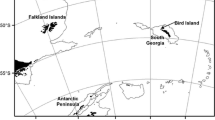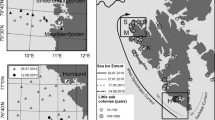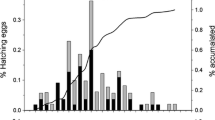Abstract.
Cephalopods play an important role in the diet of many predators of the Southern Ocean. We investigated the cephalopod component of the diet of the wandering albatross, during breeding at South Georgia, from 269 boluses containing more than 34,000 beaks (corresponding to 19,452 individual cephalopods), collected between 1989 and 1999, and assessed the inter-annual variability of the cephalopod species, the level of scavenging on cephalopods by wandering albatrosses and the relationships between cephalopod availability and wandering albatross breeding parameters (breeding period, breeding success, fledging period, fledging success, egg mass and chick mass). We also proposed possible foraging areas of wandering albatrosses based on the cephalopods eaten. The cephalopod component of the diet of wandering albatrosses was relatively stable over the 11 years of the study. By number of lower beaks, three species predominated in the cephalopod component of the diet: Kondakovia longimana (29.5% of the total number of lower beaks; family Onychoteuthidae), Taonius sp. (20.4%; family Cranchiidae) and Histioteuthis sp. B (19.5%; family Histioteuthidae). K. longimana was consistently the predominant cephalopod species by mass in every year of the study (range 60.2–88.7% of mass contribution to diet). A minimum estimate of 30% of the number of cephalopods scavenged corresponded to 85% of the total mass of the cephalopods that contributed to the diet. Wandering albatrosses fed consistently more on "Antarctic" cephalopods than on "sub-Antarctic" or "subtropical" cephalopods in all years of the study, suggesting that Antarctic waters are an important foraging area for wandering albatrosses. Although some significant correlations between cephalopod abundance and wandering albatross breeding parameters existed (e.g. correlation between Taonius sp. by number and fledging success), none included K. longimana. When comparing groups of variables (using canonical analysis), no correlations were found between the most important cephalopod species (by number and by mass), total mass of squid consumed, cephalopod diversity index (H) for each year, and wandering albatross breeding parameters. This may reflect the possibility that other components in the diet (e.g. fish and carrion) are more important or, more likely, that the consistency across years of the wandering albatross breeding performance indicates that it is well buffered against fluctuations in prey availability.
Similar content being viewed by others
Author information
Authors and Affiliations
Additional information
Electronic Publication
Rights and permissions
About this article
Cite this article
Xavier, .J., Croxall, .J., Trathan, .P. et al. Inter-annual variation in the cephalopod component of the diet of the wandering albatross, Diomedea exulans, breeding at Bird Island, South Georgia. Marine Biology 142, 611–622 (2003). https://doi.org/10.1007/s00227-002-0962-y
Received:
Accepted:
Issue Date:
DOI: https://doi.org/10.1007/s00227-002-0962-y




